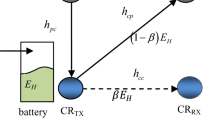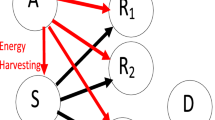Abstract
The performance analysis of a relay based cognitive radio (CR) network (non-cooperative and cooperative) with a combined (radio frequency (RF) and non-RF) energy harvesting under a collision constraint of a primary user (PU) is studied in this paper. Cooperative environment includes a network with multiple PUs, and CRs. The relay and CR at the destination employes multiple antenna for receive diversity. Both the CR source and relay node are considered as energy harvesting nodes. The CR source harvests the energy from RF signal of PU and non-RF signal over the detection cycle. In contrast, the relay node harvests the energy from non-RF signal and CR signal. Network performance is studied for instantaneous transmission and delay constraint transmission. Situations of relay node not transmitting due to insufficient harvested energy is captured, where harvested energy falls below a threshold causing energy outage. A probabilistic approach is adopted to redesign the expression of network throughput. Two protocols, namely, amplify-forward and decode-forward relaying are discussed. Novel analytical expressions are developed for outage probability and throughput. The impacts of several parameters of the network like collision probability, transmitting signal-to-noise ratio (SNR), fractional harvesting time parameter and fractional transmission time parameter on the system throughput are investigated and compared. An optimal value of fractional harvesting time parameter is estimated for maximization of throughput under a collision constraint of PU. Throughput increases as the sensing duration, non-RF energy mean, transmission SNR, and collision probability decrease. There is an optimal value of fractional harvesting time which maximizes the throughput. The combination of AND fusion rule and MRC data combining performs better compare to the other schemes.



















Similar content being viewed by others
References
Ghasemi, A., & Sousa, E. S. (2007). Opportunistic spectrum access in fading channels through collaborative sensing. Journal of Communications, 2(2), 71–82.
Singh, A., Bhatnagar, M.R., & Mallik, R.K. (2011). Cooperative spectrum sensing with an Improved energy detector in cognitive radio network, In Proceedings of national conference on communications.
Shi, S., Li, Y., Gu, S., Huang, T., & Gu, X. (2020). Time allocation optimization and trajectory design in UAV-assisted energy and spectrum harvesting network. IEEE Access, 8, 160537–160548.
Liang, Y. C., Zeng, Y., Peh, E. C. Y., & Tuan Hong, A. (2008). Sensing-throughput tradeoff for cognitive radio networks. IEEE Transactions on Wireless Communications, 7(4), 1326–1337.
Wu, Y., & Tsang, D. H. K. (2011). Energy efficient spectrum sensing and transmission for cognitive radio system. IEEE Communications Letters, 15(5), 545–547.
Cai, L., Poor, H., Liu, Y., Luan, T., Shen, X., & Mark, J. (2011). Dimensioning network deployment and resource management in green mesh networks. IEEE Communications Letters, 18(5), 58–65.
Mao, S., Cheung, M.H., Wong, V. (June 2012).“An opimal energy allocation algorithm for energy harvesting wireless sensor networks,” In Proceedings of IEEE international conference on communications (ICC’12), , 10-15 pp. 265–270.
Park, S., & Hong, D. (2014). Achievable throughput of energy harvesting cognitive radio networks. IEEE Transactions on Wireless Communications, 13(2), 1010–1022.
Bhowmick, A., Roy, S.D., Kundu, S. (2015)“Performance of secondary user with combined RF and non-RF based energy-harvesting in cognitive radio network,” In Proceedings of advanced networks and telecommuncations systems (ANTS), 2015 IEEE international conference on IEEE, Kolkata, India.
Bhowmick, A., Roy, S. D., & Kundu, S. (2016). Throughput of a cognitive radio network with energy-harvesting based on primary user signal. IEEE Wireless Communications Letters, 5(2), 136–139.
Zheng, K., Liu, X., Zhu, Y., Chi, K., & Liu, K. (2020). Total throughput maximization of cooperative cognitive radio networks with energy harvesting. IEEE Transactions on Wireless Communications, 19(1), 533–546.
Tayel, A. F., Rabia, S. I., Abd El-Malek, A. H., & Abdelrazek, A. M. (2021). Throughput maximization of hybrid access in multi-class cognitive radio networks with energy harvesting. IEEE Transactions on Communications, 69(5), 2962–2974.
Bae, Y. H., & Baek, J. W. (2019). Performance analysis of delay-constrained traffic in a cognitive radio network with RF energy harvesting. IEEE Communications Letters, 23(12), 2177–2181.
Prathima, A., Gurjar, D. S., Nguyen, H. H., & Bhardwaj, A. (2020). Performance analysis and optimization of bidirectional overlay cognitive radio networks with hybrid-swipt. IEEE Transactions on Vehicular Technology, 69(11), 13467–13481.
Bhowmick, A., Roy, S.D., & Kundu, S. (2015). Performance of secondary user with combined RF and non-RF based energy-harvesting in cognitive radio network, In Proceedings of advanced networks and telecommuncations systems (ANTS), 2015 IEEE International Conference on IEEE, Kolkata, India
Xing, J., Zhang, X., Wang, J., Zhang, Z., Wang, W. (2014). Performance analysis of cognitive relay networks with imperfect channel knowledge over Nakagami-m fading channels, In Proceedings of IEEE wireless communications and networking conference (WCNC), , pp. 839–844.
Zhang, L., Jie, Y., Xiongjun, J. (2011). Optimization of relay-based cooperative spectrum sensing in cognitive radio networks,” 2011 7th international conference on wireless communications, networking and mobile computing (pp. 1-4). IEEE.
Zhong, C., Suraweera, H. A., Zheng, G., Krikidis, I., & Zhang, Z. (2014). Wireless information and power transfer with full duplex relaying. IEEE Transactions on Communications, 62(10), 3447–3461.
Nasir, A.A., Zhou, X., Durrani, S., Kennedy, R.A. (June 2014). “Throughput and ergodic capacity of wireless energy harvesting based DF relaying network,” In Proceedings of IEEE international conference on communications (ICC’14), , 10-14 pp. 4066–4071.
Verma, D. K., Chan, R. Y., & Chieni, F. (2017). Energy-assisted decode-and-forward for energy harvesting cooperative cognitive networks. IEEE Transactions on Cognitive Communications and Networking, 3(3), 328–342.
Duy, T. T., & Kong, H. Y. (2016). Performance analysis of mixed amplify-and-forward and decode-and-forward protocol in underlay cognitive networks. China Communications, 13(3), 115–126.
Shi, Z., Chan Teah, K., & Hung Li, K. (2013). Energy efficient joint design of sensing and transmission durations for protection of primary user in cognitive radio systems. IEEE Communications Letters, 17(3), 565–568.
Zhang, R., & Ho, C. K. (2013). MIMO broadcasting for simultaneous wireless information and power transfer. IEEE Transactions on Wireless Communications, 12(5), 1989–2001.
Kim, H., Wang, H., Lim, S., & Hong, D. (2012). On the impact of outdated channel information on the capacity of secondary user in spectrum sharing environments. IEEE Transactions on Wireless Communications, 11(1), 284–295.
Hasna, M. O., & Alouini, M. S. (2004). A performance study of dual-hop transmissions with fixed gain relays. IEEE Transactions on Wireless Communications, 3(6), 1963–1968.
Hasna, M. O., & Alouini, M. S. (2003). End-to-end performance of transmission systems with relays over Rayleigh-fading channels. IEEE Transactions on Wireless Communications, 2(6), 1126–1131.
Gradshteyn, I.S., Ryzbik, I.M. (2000). Table of integrals, series, and products .
Funding
No funding was received for conducting this study
Author information
Authors and Affiliations
Corresponding author
Ethics declarations
Conflict of interest
The authors have no relevant financial or non-financial interests to disclose.
Additional information
Publisher's Note
Springer Nature remains neutral with regard to jurisdictional claims in published maps and institutional affiliations.
Appendices
Appendix A
(Proof of \(Pr\left( E_{TH, r}\ge E_{th}\right)\)):
Replacing the value of \(E_{TH, r}\) in 45 from 17 and after some algebra 45 reduces to
Since, \(|h_{sr}|^2\) is exponentially distributed, \(F_{|h_{sr}|^2}\left[ x\right] = 1- exp\left( -\frac{x}{\lambda _{sr}}\right)\). Hence, the expression obtained in , can be reduced to
Appendix B
(Proof of outage probability for AF relay):
Let \(\gamma _1=\frac{P_{CR}|h_{sr}|^2}{d_1^p N_0}=a g_{sr}\) where \(g_{sr}=|h_{sr}|^2\). Similarly, \(\gamma _2=\frac{P_{relay}|h_{rd}|^2}{(P_{CR} |{\hat{h}}_{sr}|^2/d_1^p+N_0)d_2^p N_0}=b_{AF} g_{rd}\) where \(g_{rd}=|h_{rd}|^2\). The PDF of \(\gamma _1\) and \(\gamma _2\) are \(f_{\gamma _1}(x)=\frac{1}{a \lambda _{sr}}exp\left( -\frac{x}{a \lambda _{sr}}\right)\) and \(f_{\gamma _2}(y)=\frac{1}{b_{AF} \lambda _{rd}}exp\left( -\frac{y}{b_{AF} \lambda _{rd}}\right)\) respectively.
Thus the outage probability for AF relaying can be expressed as,
Replacing \(f_{\gamma _{2}}\left( \gamma _{th}+t \right) =\frac{1}{b_{AF} \lambda _{rd}}exp\left( -\frac{\gamma _{th}+t }{b_{AF} \lambda _{rd}}\right)\) in and after some algebra, \(P_{out}\) can be obtained as,
where \(m_2=\frac{4\gamma _{th}\left( \gamma _{th}+1 \right) }{a \lambda _{sr}}\) and \(n_2=\frac{1}{b_{AF} \lambda _{sr}}\). Using [27, (3.324.1)] 48 reduces to
Appendix C
(Proof of outage probability for DF relay)
In the case of DF relaying, the PDF of \(\gamma _2\) can be written as \(f_{\gamma _2}(y)=\frac{1}{b_{DF} \lambda _{rd}}exp\left( -\frac{y}{b_{DF} \lambda _{rd}}\right)\) where \(b_{DF}=\frac{P_{relay}}{P_{CR}d_2^p N_0}\). Hence, the outage probability can be described as,
Using the CDF of \(\gamma _1\) and \(\gamma _2\) in 49, the outage probability for DF relaying can be reduced to
Rights and permissions
Springer Nature or its licensor (e.g. a society or other partner) holds exclusive rights to this article under a publishing agreement with the author(s) or other rightsholder(s); author self-archiving of the accepted manuscript version of this article is solely governed by the terms of such publishing agreement and applicable law.
About this article
Cite this article
Bhowmick, A., Prasad, B. & Nallagonda, S. Throughput and harvesting time trade-off in a energy harvesting cognitive radio network. Wireless Netw 29, 2619–2633 (2023). https://doi.org/10.1007/s11276-023-03337-1
Accepted:
Published:
Issue Date:
DOI: https://doi.org/10.1007/s11276-023-03337-1




